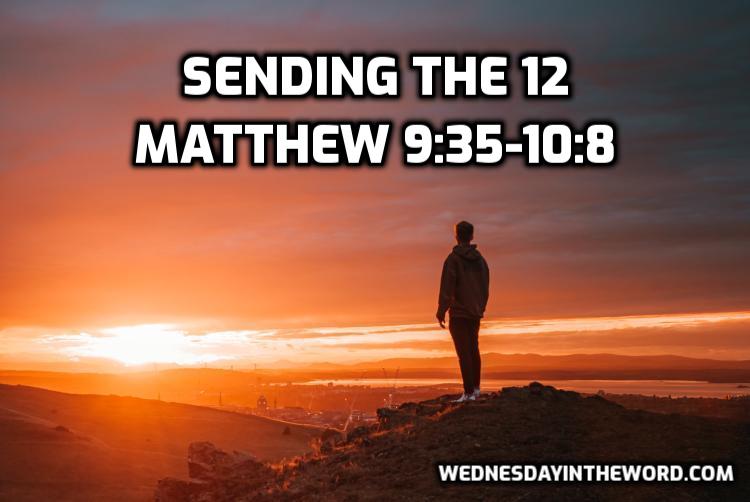Matthew presents this initial sending of the Twelve as a first step toward their ultimate global mission. Even though they are to stay in Jewish territory on this journey, ultimately, Jesus is going to send them to the world.
Review
Outline Matthew’s Gospel
- Chapters 1-4 – Prologue
- Chapters 5:1-16:12 – Jesus’ ministry in Galilee, including 3 discourses.
- Chapters 16:13-17 – Turning Point; Jesus prepares to go to Jerusalem
- Chapters 18-28 – Journey to Jerusalem, culminating in the passion week, including 2 discourses.
Passage
35And Jesus went throughout all the cities and villages, teaching in their synagogues and proclaiming the gospel of the kingdom and healing every disease and every affliction. 36When he saw the crowds, he had compassion for them, because they were harassed and helpless, like sheep without a shepherd. 37Then he said to his disciples, “The harvest is plentiful, but the laborers are few; 38therefore pray earnestly to the Lord of the harvest to send out laborers into his harvest.” – Matthew 9:35-38
- Matthew 9:35 is almost identical to Matthew 4:23.
- The imagery of a sheep without a shepherd recalls many Old Testaments passages (e.g. Isaiah 53:6; Jeremiah 50:6; Ezekiel 34:23-24).
- The people of Israel were spiritually and morally lost in a way that only Jesus, the true Shepherd, can remedy. He has come to proclaim the good news that is the solution to their troubles.
- Jesus encourages his disciples to pray that God will send more workers to proclaim his message, knowing he will send the 12 out to be those workers.
More: Sheep & Shepherd imagery in Scripture
1And he called to him his twelve disciples and gave them authority over unclean spirits, to cast them out, and to heal every disease and every affliction. 2The names of the twelve apostles are these: first, Simon, who is called Peter, and Andrew his brother; James the son of Zebedee, and John his brother; 3Philip and Bartholomew; Thomas and Matthew the tax collector; James the son of Alphaeus, and Thaddaeus; 4Simon the Zealot, and Judas Iscariot, who betrayed him. – Matthew 10:1-4
- Luke records Jesus sending out his disciples twice. First he sends only the 12 (Luke 9:1-6). Then he sends seventy (Luke 10:1-16).
- Matthew repeats the language of 4:23 “to heal every disease and every affliction” in 9:35 and applies it to the Twelve in 10:1.
- Jesus commissions the Twelve and grants them the authority to be an extension of his work.
- Mathew uses the word “apostle” for the first and only time in 10:2.
- There are 4 lists of the twelve: Matthew 10:1-4; Mark 3:16-18; Luke 6:13-16; Acts 1:12-13.
- Matthew pairs the Twelve in his list. Mark 6:7-13 tells us Jesus sent the Twelve out in pairs. Perhaps Matthew’s pairings represent who journeyed together.
- Since many apostles were still alive when Matthew wrote his gospel, this list would be important to his readers.
The four lists of the Twelve follow patterns. Each list can be divided into the same 4 groups. Each group begins with the same apostle, but the order within the group varies.
- Group 1: Simon Peter, his brother, Andrew, James & John, the sons of Zebedee
- Group 2: Philip, Bartholomew, Thomas, Matthew
- Group 3: James son of Alphaeus, Thaddaeus, Simon the Zealot, Judas Iscariot
5These twelve Jesus sent out, instructing them, “Go nowhere among the Gentiles and enter no town of the Samaritans, 6but go rather to the lost sheep of the house of Israel. 7And proclaim as you go, saying, ‘The kingdom of heaven is at hand.’ 8Heal the sick, raise the dead, cleanse lepers, cast out demons. You received without paying; give without pay.” – Matthew 10:5-8
- Much of the language in Matthew 10 is found in Mark 6 and Luke 9. But Matthew includes some of the language Mark & Luke place in the Olivet Discourse.
- Perhaps Matthew collected teachings from several different instructions. Or perhaps Jesus gave similar and overlapping instructions on more than one occasion.
- Matthew organized his gospel thematically, rather than chronologically.
- On this trip, Jesus tells them to stay in Jewish territory. The ministry to the Gentiles will come later.
- The Twelve are to do exactly what Jesus has been doing: teaching and healing.
- The promises of the kingdom were made to the children of Abraham and the gospel was proclaimed first to them. The reaction of this Jewish people to this ministry is a very important part of the story.
- The Twelve don’t know it yet, but ultimately Jesus is going to leave and send them out to the world. This trip is preparation for future trips to come.
Please listen to the podcast for more detail and explanation.
Next: 54 Matthew 10:8-23 Provisions & Persecution
Previous: 52 Matthew 9:27-34 Blind & mute
Series: Gospel of Matthew 8-13 Behold the King, Part 2
Study: Matthew Resources
Photo by Nighthawk Shoots on Unsplash
Season 20, episode 12

